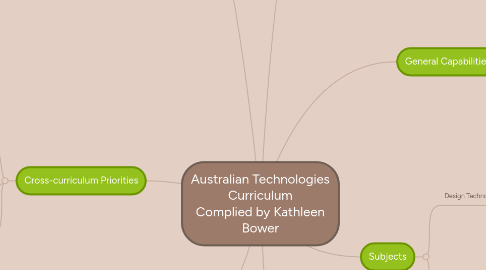
1. Achievement Standards
1.1. F - 2
1.1.1. By the end of Year 2, students identify how common digital systems (hardware and software) are used to meet specific purposes. They use digital systems to represent simple patterns in data in different ways. Students design solutions to simple problems using a sequence of steps and decisions. They collect familiar data and display them to convey meaning. They create and organise ideas and information using information systems and share information in safe online environments.
1.2. 3 - 4
1.2.1. By the end of Year 4, students describe how a range of digital systems (hardware and software) and their peripheral devices can be used for different purposes. They explain how the same data sets can be represented in different ways. Students define simple problems, design and implement digital solutions using algorithms that involve decision-making and user input. They explain how the solutions meet their purposes. They collect and manipulate different data when creating information and digital solutions. They safely use and manage information systems for identified needs using agreed protocols and describe how information systems are used.
1.3. 5 - 6
1.3.1. By the end of Year 6, students explain the fundamentals of digital system components (hardware, software and networks) and how digital systems are connected to form networks. They explain how digital systems use whole numbers as a basis for representing a variety of data types. Students define problems in terms of data and functional requirements and design solutions by developing algorithms to address the problems. They incorporate decision-making, repetition and user interface design into their designs and implement their digital solutions, including a visual program. They explain how information systems and their solutions meet needs and consider sustainability. Students manage the creation and communication of ideas and information in collaborative digital projects using validated data and agreed protocols.
1.4. 7 - 8
1.4.1. By the end of Year 8, students distinguish between different types of networks and defined purposes. They explain how text, image and audio data can be represented, secured and presented in digital systems. Students plan and manage digital projects to create interactive information. They define and decompose problems in terms of functional requirements and constraints. Students design user experiences and algorithms incorporating branching and iterations, and test, modify and implement digital solutions. They evaluate information systems and their solutions in terms of meeting needs, innovation and sustainability. They analyse and evaluate data from a range of sources to model and create solutions. They use appropriate protocols when communicating and collaborating online.
1.5. 9 - 10
1.5.1. By the end of Year 10, students explain the control and management of networked digital systems and the security implications of the interaction between hardware, software and users. They explain simple data compression, and why content data are separated from presentation. Students plan and manage digital projects using an iterative approach. They define and decompose complex problems in terms of functional and non-functional requirements. Students design and evaluate user experiences and algorithms. They design and implement modular programs, including an object-oriented program, using algorithms and data structures involving modular functions that reflect the relationships of real-world data and data entities. They take account of privacy and security requirements when selecting and validating data. Students test and predict results and implement digital solutions. They evaluate information systems and their solutions in terms of risk, sustainability and potential for innovation and enterprise. They share and collaborate online, establishing protocols for the use, transmission and maintenance of data and projects.
2. Cross-curriculum Priorities
2.1. Aboriginal and Torres Strait Islander Histories and Culture
2.1.1. Students identify, explore, understand, and analyse the interconnectedness between technologies and Identity, People, Culture, and Country/Place.
2.2. Asia nd Australia's engagement with Asia
2.2.1. Students recognise that the interaction between human activity and the diverse environments of the Asia region continues to create the need for creative solutions and collaboration with others.
2.3. Sustainability
2.3.1. Students focus on the knowledge, understanding and skills necessary to choose technologies and systems with regard to costs and benefits. They evaluate the extent to which the process and designed solutions embrace sustainability. Students reflect on past and current practices, and assess new and emerging technologies from a sustainability perspective.
3. Student Diversity
3.1. Students with a disability
3.2. English as an additional language or dialect
3.3. Gifted and Talented
4. Aims
4.1. •investigate, design, plan, manage, create and evaluate solutions
4.2. •are creative, innovative and enterprising when using traditional, contemporary and emerging technologies, and understand how technologies have developed over time
4.3. •make informed and ethical decisions about the role, impact and use of technologies in the economy, environment and society for a sustainable future
4.4. •engage confidently with and responsibly select and manipulate appropriate technologies − materials, data, systems, components, tools and equipment − when designing and creating solutions
4.5. •critique, analyse and evaluate problems, needs or opportunities to identify and create solutions.
5. Subjects
5.1. Design Technologies
5.1.1. STRAND: Knowledge and Understanding
5.1.1.1. Technology in Society (the use, development, and impact of technologies in peoples lives)
5.1.1.2. Technology Contexts (technologies and design across a range of technologies contexts)
5.1.2. STRAND: Processes and Production Skills
5.1.2.1. Creating design solutions by: investigating, generating, producing, evaluating, and collaborating and managing.
5.2. Digital technologies
5.2.1. STRAND: Knowledge and Understanding
5.2.1.1. Digital Systems (the components of digital systems: hardware, software, and networks and their use)
5.2.1.2. Representation of Data (how data are represented and structured symbolically)
5.2.2. STRAND: Processes and Production Skills
5.2.2.1. Collecting, managing and analysing data. Creating digital solutions by: defining, designing, implementing, evaluating, and collaborating and managing.
